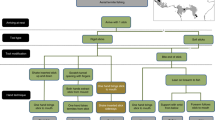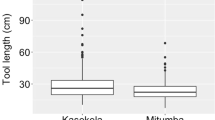Abstract
As an increasing number of field studies of chimpanzees (Pan troglodytes) have achieved long-term status across Africa, differences in the behavioural repertoires described have become apparent that suggest there is significant cultural variation1,2,3,4,5,6,7. Here we present a systematic synthesis of this information from the seven most long-term studies, which together have accumulated 151 years of chimpanzee observation. This comprehensive analysis reveals patterns of variation that are far more extensive than have previously been documented for any animal species except humans8,9,10,11. We find that 39 different behaviour patterns, including tool usage, grooming and courtship behaviours, are customary or habitual in some communities but are absent in others where ecological explanations have been discounted. Among mammalian and avian species, cultural variation has previously been identified only for single behaviour patterns, such as the local dialects of song-birds12,13. The extensive, multiple variations now documented for chimpanzees are thus without parallel. Moreover, the combined repertoire of these behaviour patterns in each chimpanzee community is itself highly distinctive, a phenomenon characteristic of human cultures14 but previously unrecognised in non-human species.
This is a preview of subscription content, access via your institution
Access options
Subscribe to this journal
Receive 51 print issues and online access
$199.00 per year
only $3.90 per issue
Buy this article
- Purchase on Springer Link
- Instant access to full article PDF
Prices may be subject to local taxes which are calculated during checkout

Similar content being viewed by others
References
McGrew, W. C. & Tutin, C. E. G. Evidence for a social custom in wild chimpanzees? Man 13, 234–251 (1978).
Goodall, J. The Chimpanzees of Gombe: Patterns of Behavior(Harvard Univ. Press, Cambridge, Massachusetts, 1986).
Nishida, T. The Chimpanzees of the Mahale Mountains: Sexual and Life History Strategies(Tokyo Univ. Press, Tokyo, 1990).
McGrew, W. C. Chimpanzee Material Culture: Implications for Human Evolution(Cambridge Univ. Press, Cambridge, 1992).
Sugiyama, Y. in The Use of Tools by Human and Non-human Primates(eds Berthelet, A. & Chavaillon, J.) 175–187 (Clarendon, Oxford, 1993).
Wrangham, R. W., McGrew, W. C., de Waal, F. B. M. & Heltne, P. G. (eds) Chimpanzee Cultures(Harvard Univ. Press, Cambridge, Massachusetts, 1994).
Boesch, C. The emergence of cultures among wild chimpanzees. Proc. Br. Acad. 88, 251–268 (1996).
Bonner, J. T. The Evolution of Culture in Animals(Princeton Univ. Press, New Jersey, 1980).
Mundinger, P. C. Animal cultures and a general theory of cultural evolution. Ethol. Sociobiol. 1, 183–223 (1980).
Lefebvre, L. & Palameta, B. in Social Learning: Psychological and Biological Perspectives(eds Zentall, T. & Galef, B. G. Jr) 141–164 (Erlbaum, Hillsdale, New Jersey, 1988).
McGrew, W. C. Culture in non-human primates? Annu. Rev. Anthropol. 27, 301–328 (1998).
Marler, P. & Tamura, M. Song ‘dialects’ in three populations of white-crowned sparrows. Science 146, 1483–1486 (1964).
Catchpole, C. K. & Slater, P. J. B. Bird Song: Themes and Variations(Cambridge Univ. Press, Cambridge, 1995).
Murdock, G. P. Ethnographic Atlas(Univ. Pittsburgh Press, Pittsburgh, 1967).
Kroeber, A. L. & Kluckhohn, C. Culture: A Critical Review of Concepts and Definitions(Random House, New York, 1963).
Bloch, M. Language, anthropology and cognitive science. Man 26, 183–198 (1991).
Nishida, T. in Primate Societies(eds Smuts, B. B., Cheney, D. L., Seyfarth, R. M., Wrangham, R. W. & Struhsaker, T. T.) 462–474 (Univ. Chicago Press, Chicago, 1987).
Whiten, A. & Ham, R. On the nature of imitation in the animal kingdom: reappraisal of a century of research. Adv. Study Behav. 21, 239–283 (1992).
Imanishi, K. Identification: A process of enculturation in the subhuman society of Macaca fuscata . Primates 1, 1–29 (1957).
Huffman, M. in Social Learning in Animals: The Roots of Culture(eds Heyes, C. M. & Galef, B. G.) 267–289 (Academic Press, London, 1996).
Boesch, C., Marchesi, P., Marchesi, N., Fruth, B. & Joulian, F. Is nut cracking in wild chimpanzees a cultural behaviour? J. Hum. Evol. 26, 325–338 (1994).
Galef, B. G. J The question of animal culture. Hum. Nature 3, 157–178 (1992).
Tomasello, M., Kruger, A. C. & Ratner, H. H. Cultural learning. Behav. Brain Sci. 16, 495–552 (1993).
Whiten, A., Custance, D. M., Gomez, J.-C., Teixidor, P. & Bard, K. A. Imitative learning of artificial fruit-processing in children (Homo sapiens) and chimpanzees (Pan troglodytes). J. Comp. Psychol. 110, 3–14 (1996).
Whiten, A. Imitation of the sequential structure of actions by chimpanzees (Pan troglodytes). J. Comp. Psychol. 112, 270–281 (1998).
Spence, K. W. Experimental studies of learning and the mental processes in infra-human primates. Psychol. Bull. 34, 806–850 (1937).
Sumita, K., Kitahara-Frisch, J. & Norikoshi, K. The acquisition of stone tool use in captive chimpanzees. Primates 26, 168–181 (1985).
Tomasello, M., Davis, Dasilv, M., Dasilv M. Camak, L. & Bard, K. Observational learning of tool-use by young chimpanzees. Hum. Evol. 2, 175–183 (1987).
Paquett, D. Discovering and learning tool-use for fishing honey by captive chimpanzees. Hum. Evol. 7, 17–30 (1992).
Nagell, K., Olguin, K. & Tomasello, M. Processes of social learning in the tool use of chimpanzees (Pan troglodytes) and children (Homo sapiens). J. Comp. Psychol. 107, 174–186 (1993).
Acknowledgements
We thank T. Matsuzawa, G. Yamakoshi, H. Boesch, D. A. Collins, S. Kamenya, H.Matama, H. Mkono, E. Mpongo, J. Salala, M. Huffman, M. Kasagula, R. Nyundo, S. Uehara, K.Arnold, C. Assersohn, K. Fawcett, J. Kakura, Z. Kiwede, G. Muhumuza, N. Newton-Fisher, P.Pebsworth, E. Stokes, J. Tinka, A. Arcadi, C. Katongole, G. Isabiriye-Basuta, F. Mugurusi, M. Muller and M. Wilson for contributions to the database; D. A. Collins, D. I. Perrett and P. J. B. Slater for advice on the manuscript; and S. Smart for the graphics of Fig. 1.
Author information
Authors and Affiliations
Supplementary information
Supplementary information
An extended graphical database (unrefereed) of this material is also available (http://chimp.st-and.ac.uk/cultures). (DOC 25 kb)
Rights and permissions
About this article
Cite this article
Whiten, A., Goodall, J., McGrew, W. et al. Cultures in chimpanzees. Nature 399, 682–685 (1999). https://doi.org/10.1038/21415
Received:
Accepted:
Issue Date:
DOI: https://doi.org/10.1038/21415
This article is cited by
-
Future coexistence with great apes will require major changes to policy and practice
Nature Human Behaviour (2024)
-
Christophe Boesch (1951–2024): Primatology Pioneer with a Long-Term Vision for Research and Conservation
International Journal of Primatology (2024)
-
Behavioral repertoire of Lahille’s bottlenose dolphins that interact with artisanal fishers
Behavioral Ecology and Sociobiology (2024)
-
Generation of chimpanzee induced pluripotent stem cell lines for cross-species comparisons
In Vitro Cellular & Developmental Biology - Animal (2024)
-
Naïve, adult, captive chimpanzees do not socially learn how to make and use sharp stone tools
Scientific Reports (2023)
Comments
By submitting a comment you agree to abide by our Terms and Community Guidelines. If you find something abusive or that does not comply with our terms or guidelines please flag it as inappropriate.



